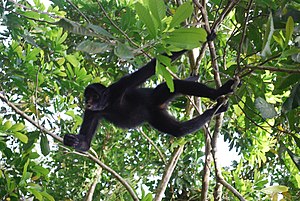Black face spider monkey
| Black face spider monkey | ||||||||||||
|---|---|---|---|---|---|---|---|---|---|---|---|---|

Black- faced spider monkey ( Ateles chamek ) |
||||||||||||
| Systematics | ||||||||||||
|
||||||||||||
| Scientific name | ||||||||||||
| Ateles chamek | ||||||||||||
| ( Humboldt , 1812) |

The black face spider monkey ( Ateles chamek ) is in South America living primate species from the family of atelidae (Atelidae).
features
Black- faced spider monkeys , like all spider monkeys, are slender primates. The limbs are long and thin, the hands hook-shaped and the thumb receded as an adaptation to the poor locomotion. The tail, which is longer than the body, is designed as a prehensile tail: it is hairless in the rear part on the underside. The fur of these animals is colored black, the eponymous feature is their black, hairless face, in contrast to related species.
distribution and habitat
These primates live in western Brazil (south of the Rio Solimões and west of the Rio Tapajós ) as well as in eastern Peru and northern Bolivia . Their habitat are lowland rainforests .
Way of life
Black-faced spider monkeys are diurnal tree dwellers. They move quickly and skillfully in the branches and use the prehensile tail like a fifth limb. When eating, they can hang on the tail or a limb for longer. They live in groups of up to 30 animals, which often split up into subgroups while foraging for food. The diet of these animals consists mainly of fruits, to a lesser extent leaves and other parts of plants.
Systematics
The black- faced spider monkey was long considered under the scientific name Ateles paniscus chamek as a subspecies of the red-faced spider monkey , later as a subspecies of the white- forehead spider monkey ( Ateles belzebuth ). Colin Groves had been advocating the thesis that the black-faced spider monkey should be viewed as an independent species since 1989. This view has largely prevailed since then.
Danger
The main threat to the black-faced spider monkey is hunting for its meat. In addition, their habitat is being destroyed by deforestation and mining. Field, he is still common, but since the overall population has declined significantly, he is by the IUCN (as "critically endangered" endangered ) classified. In 2003 it was still listed as “not at risk” ( least concern ).
Individual evidence
- ^ R. Kellogg & EA Goldman: Review of the spider monkeys. Proceedings of the Proceedings of the United States National Museum, 96, pp. 1-45, 1944
- ^ MAA Medeiros, RMS Barros, JC Pieczarka, CY Nagamachi, M. Ponsà, M. Garcia, F. Garcia & J. Egozcue: Radiation and speciation of spider monkeys, genus Ateles, from the cytogenetic viewpoint. American Journal of Primatology, 42, pp. 167-178, 1997
- ^ Colin Peter Groves: A Theory of Human and Primate Evolution. Oxford University Press, New York 1989
- ↑ Don E. Wilson, DeeAnn M. Reeder (Ed.): Mammal Species of the World. A taxonomic and geographic Reference. Johns Hopkins University Press, Baltimore MD 2005
- ↑ Ateles chamek in the endangered Red List species the IUCN 2014 Posted by: RB Wallace, RA Mitter Meier, F. Cornejo & JP Boubli, 2008. Accessed February 2, 2015.
literature
- Thomas Geissmann : Comparative Primatology. Springer-Verlag, Berlin et al. 2003, ISBN 3-540-43645-6 .
- Don E. Wilson, DeeAnn M. Reeder (Eds.): Mammal Species of the World. A taxonomic and geographic Reference. Johns Hopkins University Press, Baltimore MD 2005, ISBN 0-8018-8221-4 .
Web links
- Ateles chamek in the endangered Red List species the IUCN 2014 Posted by: RB Wallace, RA Mitter Meier, F. Cornejo & JP Boubli, 2008. Accessed February 2, 2015.